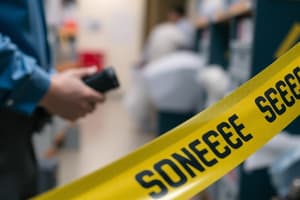Podcast
Questions and Answers
What is the primary purpose of submitting the tool used at a crime scene when collecting footprint or tire impressions?
What is the primary purpose of submitting the tool used at a crime scene when collecting footprint or tire impressions?
- To assess the tool for fingerprints
- To analyze the tool's material composition
- To link the tool to a specific footprint pattern (correct)
- To determine the weight of the tool used
Which of the following is NOT a guideline for collecting latent prints?
Which of the following is NOT a guideline for collecting latent prints?
- Store in paper envelopes (correct)
- Package in heat-sealable plastic bags
- Zip tie the items to minimize movement
- Always wear gloves
What is the correct action to take when collecting glass evidence?
What is the correct action to take when collecting glass evidence?
- Allow glass to fall freely into the container
- Store glass evidence in glass containers
- Label glass as 'inside' or 'outside' (correct)
- Use paper bags for packaging
Which of the following methods is NOT recommended for packaging controlled substances?
Which of the following methods is NOT recommended for packaging controlled substances?
Why should footwear or tire impressions in snow be sprayed with a color spray before photographing?
Why should footwear or tire impressions in snow be sprayed with a color spray before photographing?
What is the first step in the evidence collection process?
What is the first step in the evidence collection process?
Which item should be worn to avoid contamination when collecting evidence?
Which item should be worn to avoid contamination when collecting evidence?
What must be added to packages containing fresh/wet tissue samples during transportation?
What must be added to packages containing fresh/wet tissue samples during transportation?
What type of evidence should be packaged separately to avoid cross-contamination?
What type of evidence should be packaged separately to avoid cross-contamination?
Which label must be included when mailing evidence associated with bloodborne pathogens?
Which label must be included when mailing evidence associated with bloodborne pathogens?
Why is a Safety Data Sheet important for hazardous materials?
Why is a Safety Data Sheet important for hazardous materials?
What is required before moving a body in Texas for examination?
What is required before moving a body in Texas for examination?
What is the correct procedure for collecting maggots as evidence?
What is the correct procedure for collecting maggots as evidence?
Which of the following is NOT a guideline for collecting blood samples?
Which of the following is NOT a guideline for collecting blood samples?
What types of items can contain DNA evidence?
What types of items can contain DNA evidence?
When submitting hair evidence, what is the recommended number of hairs to collect?
When submitting hair evidence, what is the recommended number of hairs to collect?
What is the proper way to handle and ship firearms as evidence?
What is the proper way to handle and ship firearms as evidence?
What should be done with paint chips collected as evidence?
What should be done with paint chips collected as evidence?
Which of the following is essential for collecting DNA evidence from fluids?
Which of the following is essential for collecting DNA evidence from fluids?
What is a potential outcome of fiber examinations?
What is a potential outcome of fiber examinations?
Which of the following is a guideline for collecting toolmark evidence?
Which of the following is a guideline for collecting toolmark evidence?
What is a key safety consideration when handling firearms as evidence?
What is a key safety consideration when handling firearms as evidence?
Personal protective gear must always be worn when collecting physical evidence.
Personal protective gear must always be worn when collecting physical evidence.
Hazardous materials can be shipped without adhering to US Department of Transportation regulations.
Hazardous materials can be shipped without adhering to US Department of Transportation regulations.
Bones should be collected in plastic bags to prevent damage during evidence collection.
Bones should be collected in plastic bags to prevent damage during evidence collection.
When mailing evidence that may contain bloodborne pathogens, packages must have a biohazard warning label.
When mailing evidence that may contain bloodborne pathogens, packages must have a biohazard warning label.
All evidence packages should be sealed with tape but do not require initialing.
All evidence packages should be sealed with tape but do not require initialing.
Maggots should be recorded based on their size and temperature.
Maggots should be recorded based on their size and temperature.
In Texas, any individual can collect blood from a live person without a warrant.
In Texas, any individual can collect blood from a live person without a warrant.
Hair samples should be submitted in a druggist fold then an evidence bag after packaging separately from different areas.
Hair samples should be submitted in a druggist fold then an evidence bag after packaging separately from different areas.
Blood samples for DWI cases must be collected in two 10mL tubes.
Blood samples for DWI cases must be collected in two 10mL tubes.
Fiber examinations can reveal specific details about the fiber's manufacturer and model.
Fiber examinations can reveal specific details about the fiber's manufacturer and model.
Cigarette butts, chewing gum, and blood can all contain DNA evidence.
Cigarette butts, chewing gum, and blood can all contain DNA evidence.
Firearms must be mailed loaded to ensure safety during transportation.
Firearms must be mailed loaded to ensure safety during transportation.
Paint chips can only indicate the color of an automobile and provide no other relevant information.
Paint chips can only indicate the color of an automobile and provide no other relevant information.
Forceps should be used to pick up physical items when collecting DNA evidence.
Forceps should be used to pick up physical items when collecting DNA evidence.
The entire garment should be submitted when collecting fiber evidence if possible.
The entire garment should be submitted when collecting fiber evidence if possible.
What is the primary purpose of a crime scene investigation?
What is the primary purpose of a crime scene investigation?
A secondary crime scene refers to the initial location where a crime occurred.
A secondary crime scene refers to the initial location where a crime occurred.
Name one of the four major search patterns used in crime scene investigations.
Name one of the four major search patterns used in crime scene investigations.
To legally enter a crime scene in the US, investigators must obtain a __________.
To legally enter a crime scene in the US, investigators must obtain a __________.
Match the following terms with their definitions:
Match the following terms with their definitions:
What does the line/strip method involve?
What does the line/strip method involve?
Investigators should follow a single ideal method for searching a crime scene.
Investigators should follow a single ideal method for searching a crime scene.
What are two of the goals of searching a crime scene?
What are two of the goals of searching a crime scene?
What is the primary advantage of using the grid method of crime scene search?
What is the primary advantage of using the grid method of crime scene search?
The spiral method of crime scene search can only begin at the perimeter of the area.
The spiral method of crime scene search can only begin at the perimeter of the area.
What is one benefit of using the zone/quadrant method in crime scene searches?
What is one benefit of using the zone/quadrant method in crime scene searches?
The ________ method involves investigators viewing the crime scene as a circle and can spiral inward or outward.
The ________ method involves investigators viewing the crime scene as a circle and can spiral inward or outward.
Match the crime scene search method with its feature:
Match the crime scene search method with its feature:
Which search method is generally more time-consuming, but also more comprehensive?
Which search method is generally more time-consuming, but also more comprehensive?
Evidence identification markers are used during the search process by investigators.
Evidence identification markers are used during the search process by investigators.
Flashcards
Physical Evidence
Physical Evidence
Evidence used in court based on forensic science. It must be collected and presented according to legal rules to be admissible.
Secure the Crime Scene
Secure the Crime Scene
The first step in evidence collection is safeguarding the area to protect evidence and prevent contamination.
Documenting Evidence
Documenting Evidence
Creating a detailed record of the evidence found, including photos, videos, and sketches.
Collecting and Packaging Evidence
Collecting and Packaging Evidence
Signup and view all the flashcards
Hazardous Materials
Hazardous Materials
Signup and view all the flashcards
Human Remains
Human Remains
Signup and view all the flashcards
Entomological Evidence
Entomological Evidence
Signup and view all the flashcards
Lysis
Lysis
Signup and view all the flashcards
Footprint/Tire Impression
Footprint/Tire Impression
Signup and view all the flashcards
Latent Print
Latent Print
Signup and view all the flashcards
Glass Evidence
Glass Evidence
Signup and view all the flashcards
Controlled Substance
Controlled Substance
Signup and view all the flashcards
DNA Evidence
DNA Evidence
Signup and view all the flashcards
Collecting DNA Evidence
Collecting DNA Evidence
Signup and view all the flashcards
Blood-Alcohol Concentration (BAC)
Blood-Alcohol Concentration (BAC)
Signup and view all the flashcards
Collecting Blood Samples (DWI)
Collecting Blood Samples (DWI)
Signup and view all the flashcards
Fiber Evidence
Fiber Evidence
Signup and view all the flashcards
Hair Evidence
Hair Evidence
Signup and view all the flashcards
Ballistics
Ballistics
Signup and view all the flashcards
Collecting Firearms & Bullets
Collecting Firearms & Bullets
Signup and view all the flashcards
Paint Chip Evidence
Paint Chip Evidence
Signup and view all the flashcards
Toolmark Evidence
Toolmark Evidence
Signup and view all the flashcards
Cross Contamination
Cross Contamination
Signup and view all the flashcards
Evidence Packaging
Evidence Packaging
Signup and view all the flashcards
Biohazard Labels
Biohazard Labels
Signup and view all the flashcards
Safety Data Sheet (SDS)
Safety Data Sheet (SDS)
Signup and view all the flashcards
Crawling Insect Evidence
Crawling Insect Evidence
Signup and view all the flashcards
Maggot Evidence
Maggot Evidence
Signup and view all the flashcards
What is the most valuable forensic evidence?
What is the most valuable forensic evidence?
Signup and view all the flashcards
Collecting DNA from Fluids
Collecting DNA from Fluids
Signup and view all the flashcards
Hair Evidence Analysis
Hair Evidence Analysis
Signup and view all the flashcards
Fiber Evidence Analysis
Fiber Evidence Analysis
Signup and view all the flashcards
Firearms Evidence
Firearms Evidence
Signup and view all the flashcards
Crime Scene
Crime Scene
Signup and view all the flashcards
Primary Crime Scene
Primary Crime Scene
Signup and view all the flashcards
Secondary Crime Scene
Secondary Crime Scene
Signup and view all the flashcards
Search Warrant
Search Warrant
Signup and view all the flashcards
Line/Strip Search
Line/Strip Search
Signup and view all the flashcards
Spiral Search
Spiral Search
Signup and view all the flashcards
Grid Search
Grid Search
Signup and view all the flashcards
Zone/Quadrant Search
Zone/Quadrant Search
Signup and view all the flashcards
Spiral Search Method
Spiral Search Method
Signup and view all the flashcards
Grid Search Method
Grid Search Method
Signup and view all the flashcards
Zone/Quadrant Search Method
Zone/Quadrant Search Method
Signup and view all the flashcards
What is the benefit of a grid search?
What is the benefit of a grid search?
Signup and view all the flashcards
When to use the Zone/Quadrant Method?
When to use the Zone/Quadrant Method?
Signup and view all the flashcards
What is an evidence marker?
What is an evidence marker?
Signup and view all the flashcards
Why is proper documentation important?
Why is proper documentation important?
Signup and view all the flashcards
Study Notes
Evidence Collection & Chain of Custody
- Physical evidence is admissible in court if legal rules were followed throughout the process.
- Evidence collection follows these steps:
- Secure the crime scene
- Locate the evidence
- Document the evidence (videos, photos, sketches)
- Collect and package the evidence
- Personal protective gear (gloves, shoe covers, face masks) must be used and changed between rooms to prevent cross-contamination.
- Evidence needing testing should be packaged separately.
Important Considerations
- Protective gear should always be worn.
- Change personal protective gear to prevent cross-contamination.
- Properly label packages with the item number, case number, the person who sealed it, date, and location.
- Seal packages with tape and initial.
Collecting Hazardous Materials
- Hazardous materials (health, safety, property, or environment risk) are frequently encountered at crime scenes.
- Shipping hazardous evidence must comply with DOT and International Air Transport Association (IATA) regulations.
- Evidence potentially containing bloodborne pathogens requires biohazard warning labels.
- Complete safety data sheets must be available for hazardous materials.
Collecting Human Remains
- Human remains may need specialized examination.
- No body movement in Texas until a Justice of the Peace signs off on a death certificate.
- Guidelines for collecting human remains:
- Collect bones in paper bags
- Use tin foil around fragile bones
- Seal fresh/wet tissue in plastic
- Include ice packs with tissue samples
- Label the package with biohazard labels.
Collecting Entomological Evidence
- Insect life cycles and succession can show the time since death.
- Guidelines for collecting entomological evidence:
- Use an insect net to catch adult and flying insects.
- Place insects in a 70% isopropyl alcohol solution (mixed 1:1 with water).
- Use forceps for crawling insects; place in the same alcohol solution
- Record temperature.
- Collect largest maggots from multiple sites and place in a solution.
Collecting DNA Evidence
- DNA evidence from fluids is crucial in court trials.
- Examples of DNA evidence: cigarette butts, chewing gum, envelopes, blood, urine, semen.
- Proper procedures include:
- Using forceps to pick up physical items.
- Using lab-grade Q-tips to collect fluids, and adding distilled water.
- Rubbing for 15 seconds, letting it dry, and placing in a suitable sealed container.
- Refrigerate until mailing.
Collection of Blood Samples (DWI)
- In Texas, only a qualified medical expert can collect blood with consent or a warrant.
- This is common in Driving While Intoxicated (DWI) cases for blood alcohol concentration analyses.
- Collection guidelines:
- Collect two 5mL blood tubes for each case.
- Label each tube with a case number.
- Refrigerate the blood samples.
- Package in Styrofoam.
- Seal package with a Biohazard label.
Collecting Hair & Fiber Evidence
- Fiber examinations identify fiber type and consistency
- Hair analysis identifies animal/human, race, body area, and any body alterations.
- Fiber guidelines include: submitting the entire garment if possible, folding, placing in an evidence bag, or using a druggist fold.
- Hair guidelines include: packaging samples from different areas, and collecting at least 25 hairs for sampling.
Collecting Firearms & Bullets
- Ballistics can identify if a bullet matches a specific firearm.
- Maintain safety precautions, do not mail loaded firearms.
- Guidelines:
- Package bullets separately from live ammunition
- Follow US DOT guidelines for cartridges
- Unload all firearms
- Handle firearms minimally
- Ship all evidence separately.
Collecting Paint & Toolmark Evidence
- Paint chips reveal color, manufacturer, model, and year of the automobile.
- Tools and toolmarks can be linked via lab analysis
- Guidelines for collection:
- Provide control paint chips from the car or object.
- Use leak-proof containers (pillboxes, screw-top vials).
- Avoid using plastic bags or cotton or envelopes.
- Submit the tool itself but not placed against the evidence.
Collection of Footprint & Tire Impressions
- Footprints and tire impressions are commonly found at crime scenes
- Soles and tire patterns can be identified by using national databases.
- Guidelines:
- Submit original evidence if possible;
- Air dry and package separately;
- Cover casts in bubble wrap and paper;
- Spray footwear/tire impressions with color spray before photographing.
Collecting Latent Prints
- Impressions left when a person touches an object.
- Latent prints are valuable evidence linking individuals to scenes.
- Unknown deceased individuals' fingerprints can confirm identification.
- Guidelines: Wear gloves, package in heat-sealable bags, and zip-tie to avoid movement.
Collection of Glass Evidence
- Glass may originate from one source, with direction of force visible from blows.
- Glass pieces are reconstructed to determine the original whole.
- Guidelines for collecting glass evidence:
- Use leakproof containers (film canisters, plastic pill bottles).
- Do not use paper or glass containers.
- Label glass parts as inside/outside.
- Vacuum glass particles if possible.
Collection of Controlled Substances
- Drugs' manufacture, possession, or use are regulated.
- Drug possession is a common arrest offense.
- Guidelines for collection include wearing gloves, a mask when powders are involved, calling for medical assistance if contaminated, and separately packaging substances.
Collection of Arson Evidence
- Arson involves intentionally setting a fire.
- Arson examinations detect ignitable liquids, identifying fuels, and solvents.
- Guidelines include using airtight containers for all evidence, appropriate containers for paint cans, and leaving space at the top for expansion during shipping.
Collection of Document Evidence
- Questioned documents are handwritten, typed, or otherwise marked, authenticity is in dispute.
- Guidelines for collecting document evidence:
- Maintain original condition
- Avoid unnecessary handling (folding, tearing, marking, stamping, soiling).
Chain of Custody
- Chain of Custody documents steps for custody, transfer, analysis, and storage of evidence.
- Evidence is carefully tracked to avoid planting or tampering, and cross contamination.
- Detailed documentation is needed including date, time, case number, persons of interest, offense, and the person sealing the evidence.
Studying That Suits You
Use AI to generate personalized quizzes and flashcards to suit your learning preferences.




